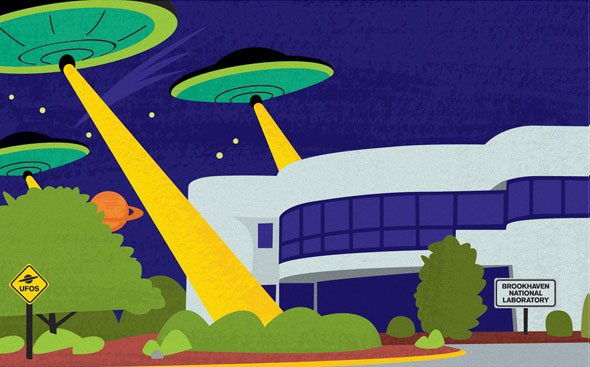Nope, no UFOs at Brookhaven Lab
 |
| Illustration: Sandbox Studio |
The spotlight caught Todd Satogata. The camera zoomed in.
“Did your particle beam shoot down a UFO?” the TV host asked.
The accelerator physicist at RHIC, Brookhaven National Laboratory's Relativistic Heavy Ion Collider, smiled.
Of course not.
With a friendly countenance and confident tone, Satogata kept steering the dialogue back to physics concepts and giving the hosts of UFO Hunters, a weekly series on the History Channel, a reality check on their extraordinary claims.
Each week, UFO hunters Bill Birnes, Kevin Cook, and Pat Uskert travel to the sites of purported alien encounters. They visited Brookhaven in April to probe an alleged UFO crash Nov. 24, 1992, in South Haven Park, about five miles from the lab. UFO buffs tell of the lab's fire department responding to the crash and extinguishing massive brush fires.
Brookhaven lab Fire Chief Chuck La Salla showed the film crew a logbook entry for that evening, which noted nothing out of the ordinary and no off-site response by firefighters.
Later versions of the tale claim that firefighters brought parts of the wreck back to the lab, where scientists analyzed alien tissue. They even have the laboratory's Alternating Gradient Synchrotron, which injects particles into RHIC, shooting down the spacecraft with a highpower plasma beam.
But the sci-fi-like sniper attack couldn't have occurred. The beams that circulate in RHIC and other particle accelerators are confined to a prescribed path. Even if they did escape, they would dissipate as soon as they interacted with air.
With its history of operating research reactors and particle accelerators, Brookhaven has long been a focus of UFO fans; a Google search of the two brings up 4620 postings. Brookhaven scientists hope that if they show UFO buffs what the laboratory really does, alien tales will carry less weight.
During the TV crew's visit, RHIC was delivering protons to the STAR and PHENIX detectors. Satogata, interviewed in the main control room, found time during tape changes and sound checks to teach the crew about the science going on in the background.
“It'll be interesting to see how it's edited and how it turns out,” Satogata said after the crew wrapped up.
Mona Rowe
Click here to download the pdf version of this article.






